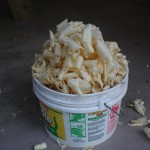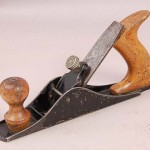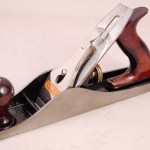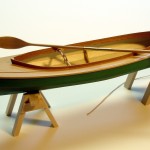 It was a simple job, the kind assigned to a newbie woodworking apprentice. Make this piece of lumber thinner. Use those hand planes over there. Don’t even think of power tools. We don’t have any that are suitable for this job.
It was a simple job, the kind assigned to a newbie woodworking apprentice. Make this piece of lumber thinner. Use those hand planes over there. Don’t even think of power tools. We don’t have any that are suitable for this job.
The lumber was a two yard long stick of common softwood, 1 x 3. I intend to use it as a mounting strip for hanging the decorative oriental rug (a gorgeous red Chinese dragon) that our son gave his mother. I wanted to use something close to 1/4 inch to minimize how much the mount stands off from the wall. This was the perfect job for learning how to use two of my “new” woodworking planes.
 The plane to use for quick stock removal is a Stanley #40 “scrub” plane. My #40 has an iron with the very old “Stanley Rule and Level Co.” trademark, which dates the plane to about 1910. A scrub plane has an iron with a curved cutting edge which is helpful for scrubbing off thick shavings. Scrubbing diagonally across the lumber makes quick work of reducing thickness while affording a reasonable degree of control.
The plane to use for quick stock removal is a Stanley #40 “scrub” plane. My #40 has an iron with the very old “Stanley Rule and Level Co.” trademark, which dates the plane to about 1910. A scrub plane has an iron with a curved cutting edge which is helpful for scrubbing off thick shavings. Scrubbing diagonally across the lumber makes quick work of reducing thickness while affording a reasonable degree of control.
I scrubbed about 1/4 inch off one side and then smoothed up the rough furrows with a Stanley #5 “jack” plane. Old stories say it is called a “jack” because it is the workhorse, “jack of all trades” plane. My #5 dates to sometime between 1933 and 1941.  This smoothing work went faster than I expected. The first dozen or so passes knocked the high ponts off the scrub furrows. It didn’t take long to work those peaks down and start producing long wide shavings. A few minutes work and the surface was plenty smooth enough for this purpose, actually a good bit smoother than when it came home from the lumber store. I also have a good smoothing plane, but this application doesn’t need to be smoother and I was more than happy using only these two planes.
This smoothing work went faster than I expected. The first dozen or so passes knocked the high ponts off the scrub furrows. It didn’t take long to work those peaks down and start producing long wide shavings. A few minutes work and the surface was plenty smooth enough for this purpose, actually a good bit smoother than when it came home from the lumber store. I also have a good smoothing plane, but this application doesn’t need to be smoother and I was more than happy using only these two planes.
Flip the board over and do the other side. Yes, I could have done it all from one side, but this was an intentional learning exercise. Think about the “Karate Kid” waxing those cars. Practice is good.
The work went quickly and easily (ok, an hour or so of learning and practice). The most important thing I learned was how well these tools work when they are well honed and tuned. The weight and momentum of the tool does the work. It was aerobic work, not strenuous work. The time I spent learning to tune up and sharpen the tools has paid off very well, but that’s a story for another post.
BTW, anyone interested in rehabilitating old planes can get excellent advice from a seasoned sawyer in the Northwest, Bob Smalser. See his “Rehabilitating Old Planes” article, and many other useful articles here and here.

